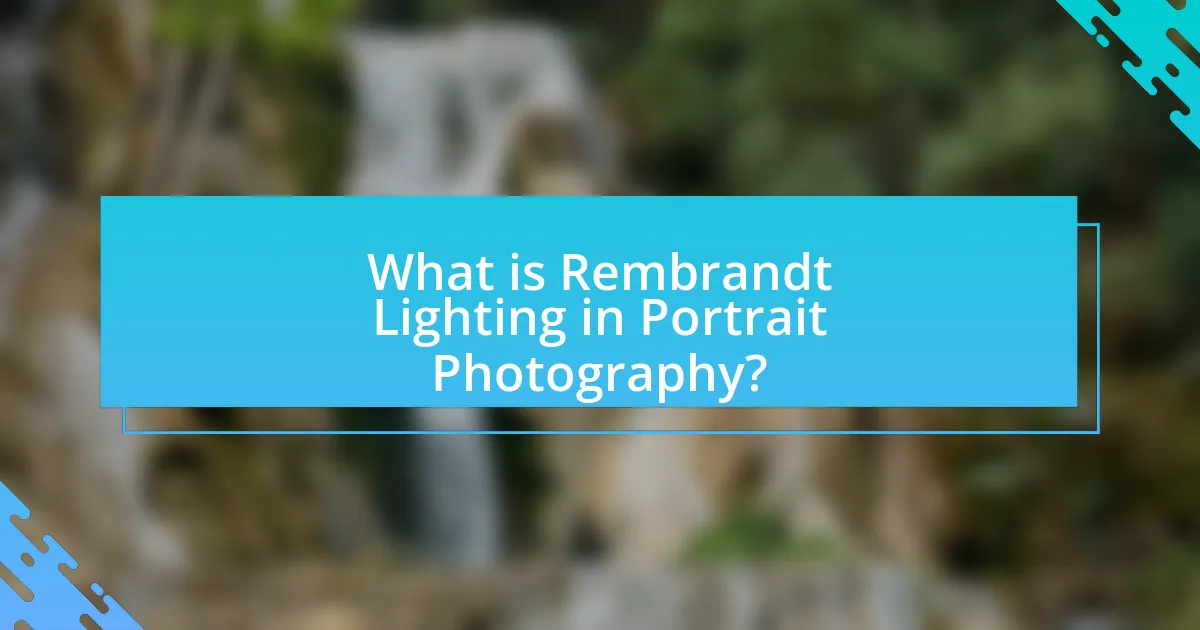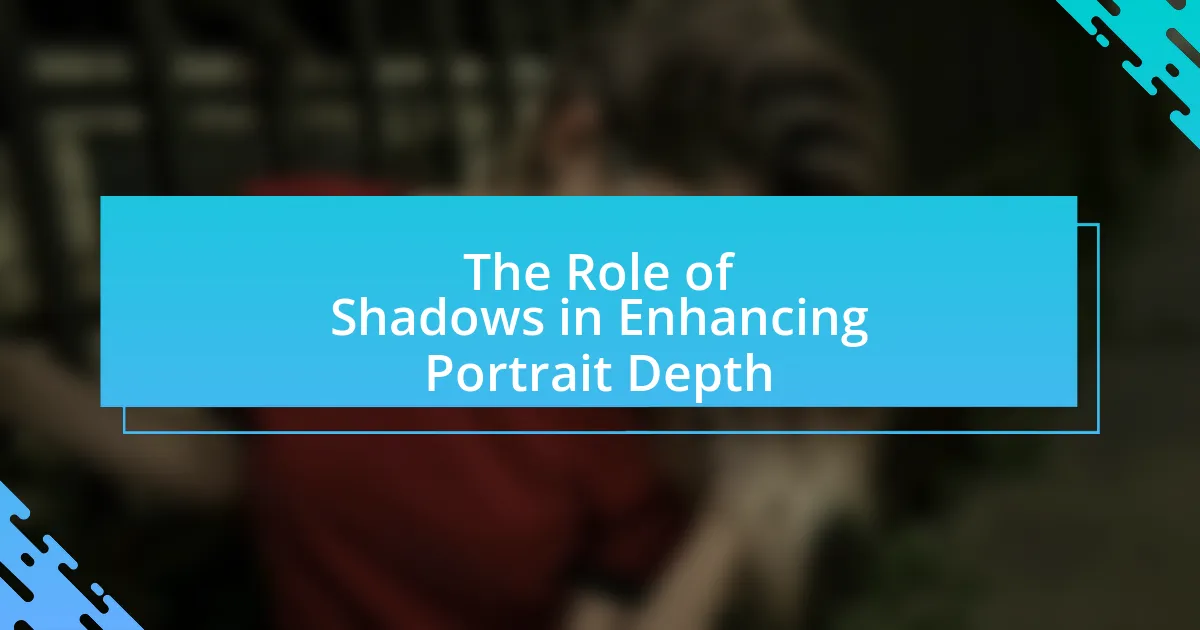Rembrandt lighting is a prominent technique in portrait photography, recognized for its distinctive triangle of light on the cheek opposite the light source, creating depth and enhancing facial features. Named after the Dutch painter Rembrandt van Rijn, this method utilizes a light source positioned at a 45-degree angle and slightly above eye level to achieve a dramatic effect. The article explores the historical significance of Rembrandt, the defining characteristics of this lighting style, its importance in conveying mood and emotion, and practical tips for photographers to master the technique. Additionally, it addresses common challenges and mistakes, as well as resources for further learning about Rembrandt lighting in portrait photography.

What is Rembrandt Lighting in Portrait Photography?
Rembrandt lighting in portrait photography is a lighting technique characterized by a distinct triangle of light on the subject’s cheek opposite the light source. This style, named after the Dutch painter Rembrandt, creates a dramatic and three-dimensional effect, enhancing facial features and adding depth to the image. The technique typically involves positioning the light source at a 45-degree angle to the subject and slightly above eye level, which results in the signature shadow pattern that defines Rembrandt lighting. This method is widely used in portrait photography for its ability to convey mood and highlight the subject’s personality effectively.
How did Rembrandt Lighting get its name?
Rembrandt Lighting is named after the Dutch painter Rembrandt van Rijn, who frequently used this lighting technique in his portraits. The style is characterized by a distinct triangle of light on the subject’s cheek opposite the light source, resembling the lighting found in many of Rembrandt’s works. This technique emphasizes depth and dimension, mirroring the dramatic chiaroscuro effect that Rembrandt employed in his paintings.
Who was Rembrandt and what is his significance in art?
Rembrandt was a Dutch painter and etcher, widely regarded as one of the greatest painters in European art history. His significance in art lies in his innovative use of light and shadow, known as chiaroscuro, which profoundly influenced the development of portrait painting. Rembrandt’s mastery of this technique is exemplified in works such as “The Night Watch” and “Self-Portrait with Two Circles,” where he skillfully creates depth and emotion, setting a standard for future artists. His ability to capture the human condition and convey psychological depth through his subjects has made him a pivotal figure in the Baroque period and a lasting influence on portrait photography and painting.
What are the defining characteristics of Rembrandt Lighting?
Rembrandt Lighting is characterized by a distinct triangular highlight on the cheek opposite the light source, creating a dramatic and three-dimensional effect. This lighting technique typically involves a single light source positioned at a 45-degree angle to the subject and slightly above eye level, which casts shadows that enhance facial features. The hallmark of Rembrandt Lighting is the balance between light and shadow, which adds depth and dimension to portraits, making it a favored choice among photographers for its ability to evoke emotion and highlight the subject’s contours.
Why is Rembrandt Lighting important in portrait photography?
Rembrandt Lighting is important in portrait photography because it creates a dramatic and three-dimensional effect that enhances the subject’s features. This lighting technique, characterized by a triangle of light on the cheek opposite the light source, adds depth and dimension, making portraits more visually engaging. Historically, Rembrandt van Rijn utilized this style to convey emotion and character in his subjects, influencing modern portrait photography practices. The technique not only flatters the subject but also establishes a mood, making it a preferred choice among photographers for capturing compelling portraits.
How does Rembrandt Lighting enhance facial features?
Rembrandt Lighting enhances facial features by creating a distinct triangle of light on the cheek opposite the light source, which adds depth and dimension to the face. This technique emphasizes the contours of the face, making features such as cheekbones and jawlines more pronounced. The contrast between light and shadow produced by this lighting style not only highlights these features but also creates a dramatic and engaging visual effect, often associated with classic portraiture. The historical use of this lighting by Rembrandt van Rijn, a master painter, demonstrates its effectiveness in enhancing facial characteristics, as seen in his portraits where the interplay of light and shadow adds emotional depth and realism.
What mood or emotion does Rembrandt Lighting convey in portraits?
Rembrandt Lighting conveys a mood of depth and introspection in portraits. This lighting technique, characterized by a triangular highlight on the cheek opposite the light source, creates a dramatic contrast that enhances facial features and evokes a sense of mystery. Historically, artists like Rembrandt used this style to portray complex emotions, allowing viewers to connect with the subject on a deeper level. The interplay of light and shadow in Rembrandt Lighting not only emphasizes the subject’s expressions but also adds a timeless quality to the portrait, reinforcing the emotional resonance captured in the image.

How can Rembrandt Lighting be achieved in practice?
Rembrandt Lighting can be achieved in practice by positioning the light source at a 45-degree angle to the subject and slightly above eye level. This setup creates a triangular highlight on the cheek opposite the light source, characteristic of Rembrandt’s style. The technique relies on the interplay of light and shadow to enhance facial features, providing depth and dimension. Historical context shows that Rembrandt van Rijn utilized this lighting to convey emotion and realism in his portraits, making it a foundational technique in portrait photography.
What equipment is needed for Rembrandt Lighting?
To achieve Rembrandt Lighting, a photographer needs a key light, typically a softbox or a large light source, positioned at a 45-degree angle to the subject. Additionally, a reflector is essential to bounce light back onto the shadow side of the face, enhancing the characteristic triangle of light on the cheek. This setup creates the distinct shadow pattern associated with Rembrandt Lighting, which is named after the painter known for his dramatic use of light and shadow.
Which types of light sources work best for this technique?
Softbox and umbrella light sources work best for Rembrandt lighting techniques in portrait photography. These light sources provide a diffused, soft light that creates the characteristic triangle of light on the subject’s cheek, which is essential for achieving the desired dramatic effect. Additionally, using a single light source positioned at a 45-degree angle to the subject enhances the shadows and highlights, further emphasizing the three-dimensionality of the face. This method is supported by the principles of light diffusion and directionality, which are critical in portrait lighting setups.
What modifiers can enhance the effect of Rembrandt Lighting?
Softboxes and umbrellas are modifiers that can enhance the effect of Rembrandt Lighting. Softboxes diffuse light, creating a softer transition between highlights and shadows, which complements the characteristic triangle of light on the subject’s cheek. Umbrellas, whether reflective or shoot-through, also soften the light and can help in controlling the spread and intensity, allowing for a more dramatic effect typical of Rembrandt Lighting. These modifiers are widely used in portrait photography to achieve the desired contrast and depth associated with this lighting style.
How should the subject be positioned for Rembrandt Lighting?
To achieve Rembrandt Lighting, the subject should be positioned at a 45-degree angle to the light source. This positioning creates a characteristic triangle of light on the cheek opposite the light source, which is essential for the Rembrandt effect. The light should be placed slightly above the subject’s eye level, allowing shadows to form under the chin and nose, enhancing the three-dimensionality of the face. This technique is rooted in the style of the painter Rembrandt van Rijn, who often used similar lighting in his portraits to create depth and drama.
What is the ideal angle for the light source?
The ideal angle for the light source in Rembrandt lighting is approximately 45 degrees from the subject and slightly above eye level. This positioning creates a characteristic triangle of light on the shadow side of the face, enhancing depth and dimension. The effectiveness of this angle is supported by the technique’s historical use in portrait photography, where it has been shown to produce flattering and dramatic effects, as evidenced by the works of Rembrandt himself, who utilized this lighting style to achieve a three-dimensional quality in his subjects.
How does the subject’s pose affect the lighting outcome?
The subject’s pose significantly influences the lighting outcome by altering the angles at which light interacts with the subject’s features. For instance, a subject turned slightly away from the light source can create dramatic shadows, enhancing the three-dimensionality of the face, which is a hallmark of Rembrandt lighting. This technique relies on the interplay of light and shadow to produce a triangular highlight on the cheek opposite the light source, emphasizing facial contours. Studies in portrait photography demonstrate that varying the subject’s head tilt or body angle can either soften or intensify these shadows, directly impacting the mood and depth of the image.

What are common challenges when using Rembrandt Lighting?
Common challenges when using Rembrandt Lighting include achieving the correct angle and intensity of light to create the signature triangle of light on the subject’s cheek. This technique requires precise positioning of the light source, typically at a 45-degree angle to the subject, which can be difficult to maintain in dynamic shooting environments. Additionally, controlling shadows is crucial, as improper lighting can lead to overly harsh contrasts or loss of detail in the darker areas of the portrait. Furthermore, achieving the desired effect may require multiple adjustments to the light source and camera settings, which can be time-consuming and may disrupt the flow of a photoshoot.
What mistakes should photographers avoid with Rembrandt Lighting?
Photographers should avoid improper positioning of the light source when using Rembrandt Lighting, as this can lead to an ineffective triangle of light on the subject’s cheek. Correctly placing the light at a 45-degree angle to the subject and slightly above eye level is essential to achieve the characteristic shadow pattern. Additionally, photographers must ensure that the light is not too harsh or too soft; using a softbox or diffuser can help create the desired effect without losing the dramatic quality of the lighting. Lastly, neglecting to control the background can result in distractions that detract from the subject, so maintaining a clean backdrop is crucial for effective Rembrandt Lighting.
How can improper lighting placement affect the portrait?
Improper lighting placement can significantly distort the features and mood of a portrait. When light is positioned incorrectly, it can create unflattering shadows, highlight unwanted textures, or fail to illuminate the subject’s face adequately. For instance, placing the light source too high can cast deep shadows under the chin, leading to a gaunt appearance, while lighting from below can create an eerie effect that is generally undesirable in portrait photography. Studies in photography emphasize that effective lighting enhances facial structure and expression, making proper placement crucial for achieving a flattering and engaging portrait.
What are the signs of overexposure or underexposure in Rembrandt Lighting?
The signs of overexposure in Rembrandt Lighting include loss of detail in the highlights, where bright areas appear washed out and lack texture. Conversely, underexposure is indicated by dark shadows that obscure facial features, resulting in a lack of contrast and detail in the image. In Rembrandt Lighting, the characteristic triangle of light on the shadow side of the face may become indistinct in overexposed images, while underexposed images may fail to reveal this triangle altogether.
How can photographers troubleshoot issues with Rembrandt Lighting?
Photographers can troubleshoot issues with Rembrandt Lighting by adjusting the light source position, modifying the subject’s angle, and controlling the background. If the characteristic triangle of light on the shadow side of the face is not visible, reposition the light source to create a more pronounced shadow. Additionally, if the lighting appears too harsh, softening the light with a diffuser can help achieve the desired effect. Adjusting the subject’s angle relative to the light source can also enhance the triangle of light, ensuring it aligns correctly with the facial features. These adjustments are essential for achieving the classic Rembrandt effect, which is defined by the interplay of light and shadow that creates depth and dimension in portrait photography.
What adjustments can be made to achieve the desired effect?
To achieve the desired effect in Rembrandt lighting for portrait photography, adjust the light source position to create a triangle of light on the subject’s cheek opposite the light. This technique requires placing the light at a 45-degree angle to the subject and slightly above eye level. The effectiveness of this adjustment is supported by the principle that the interplay of light and shadow enhances facial features, creating depth and dimension, which is characteristic of Rembrandt’s style.
How can post-processing help enhance Rembrandt Lighting in portraits?
Post-processing can enhance Rembrandt Lighting in portraits by adjusting contrast, brightness, and color balance to emphasize the characteristic triangle of light on the subject’s cheek. This technique allows photographers to refine the shadows and highlights, making the lighting more dramatic and visually appealing. For instance, increasing contrast can deepen the shadows, accentuating the three-dimensional quality of the face, while fine-tuning brightness can ensure that the light triangle remains prominent without losing detail. Additionally, color grading can enhance the mood of the portrait, aligning with the classic aesthetic associated with Rembrandt’s work.
What are some tips for mastering Rembrandt Lighting in portrait photography?
To master Rembrandt Lighting in portrait photography, position your light source at a 45-degree angle to the subject and slightly above eye level. This setup creates the characteristic triangle of light on the shadow side of the face, which is essential for achieving the desired effect. Additionally, use a soft light modifier to reduce harsh shadows while maintaining contrast, as this enhances the three-dimensionality of the subject. It is also important to ensure that the background is not overly bright, as this can distract from the subject’s face. Finally, practice adjusting the distance and intensity of the light to refine the look, as small changes can significantly impact the final image.
How can photographers practice and refine their skills with this technique?
Photographers can practice and refine their skills with Rembrandt lighting by setting up controlled lighting scenarios that mimic the technique’s characteristic shadow patterns. This involves positioning a single light source at a 45-degree angle to the subject, ensuring that the light creates a triangle of illumination on the shadowed side of the face. By experimenting with different angles, distances, and modifiers, photographers can observe how these adjustments affect the quality of light and shadow, thereby enhancing their understanding of the technique. Studies in photography education emphasize the importance of hands-on practice, indicating that repeated experimentation leads to improved skill and confidence in using specific lighting techniques.
What resources are available for learning more about Rembrandt Lighting?
Books, online courses, and video tutorials are valuable resources for learning about Rembrandt Lighting. Notable books include “Light, Science & Magic” by Fil Hunter, which explains lighting techniques including Rembrandt, and “The Photographer’s Guide to Posing” by Lindsay Adler, which covers various lighting styles. Online platforms like Udemy and Skillshare offer courses specifically focused on portrait lighting techniques, including Rembrandt Lighting. Additionally, YouTube hosts numerous tutorials from professional photographers demonstrating the setup and execution of Rembrandt Lighting in practice. These resources provide both theoretical knowledge and practical application, making them effective for learners at all levels.

















